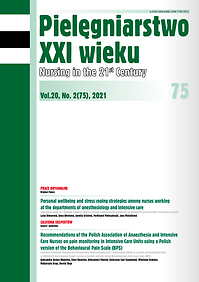Personal wellbeing and stress coping strategies among nurses working at the departments of anesthesiology and intensive care
DOI:
https://doi.org/10.2478/pielxxiw-2021-0012Keywords:
personal wellbeing, stress coping strategies, nurses, anesthesiology, intensive careAbstract
PERSONAL WELLBEING AND STRESS COPING STRATEGIES AMONG NURSES WORKING AT THE DEPARTMENTS OF ANESTHESIOLOGY AND INTENSIVE CARE
Aim. To investigate the personal wellbeing of nurses in relation to selected variables. Then to explore whether personal wellbeing has any impact on preference for stress coping strategies.
Material and methods. The sample consisted of 509 nurses working at the Department of Anaesthesiology and Intensive Medicine. We used the Personal Wellbeing Index – Adult (PWI – A) scale and coping strategies (Brief COPE) questionnaire. Data were analyzed using the methods of descriptive and inductive statistics.
Results. Subjective perception of personal wellbeing was assessed at the score 60-70% (60.85; SD±12.47). The research revealed that age and marital status had no significant impact on wellbeing in contrast to the length of work experience and education level. The lowest scores of personal wellbeing among nurses were detected in connection with their concerns regarding their future security. Nurses utilized both adaptive and maladaptive coping strategies. The study pinpointed the connection between coping strategies and personal wellbeing, in particular, in the domain of satisfaction with personal relationships and satisfaction with community connectedness.
Conclusions. Monitoring the personal wellbeing of nurses and utilizing stress coping strategies proved to be important, because these may have an impact on the work performance of nurses, personal safety, and quality of health work experiences they provide.
References
1. Kortum E, Leka S, Cox T. Psychosocial risks and work-related stress in developing countries: health impact, priorities, barriers and solutions. International Journal of Occupational Medicine and Environmental Health. 2010; 23(3): 225-238.
2. World Health Organization. Stress at the workplace. 2018.
3. Tomasina F. Problems of work world and its impact on health: Current financial crisis. Revista de Salud Publica. 2012; 14(1): 56-67.
4. Crilly J, Greenslade J, Lincoln C, et al. Measuring the impact of the working environment on emergency department nurses: A cross-sectional pilot study. International Emergency Nursing. 2017; 31: 9-14.
5. Červený M, Siaki A, McGee P, Kilíková M. Perception of European nurses of culturally-appropriate health care – A cross-sectional study. Medycyna Ogólna i Nauki o Zdrowiu. 2019; 25(1): 27-32.
6. Obročníková A, Majerníková Ľ, Gresš-Halász B. Syndróm vyhorenia ako determinant pracovnej výkonnosti sestier. Pracovní lékařství. 2019; 71(1-2): 35-41.
7. Zamboriova M, Simočková V. Psychická záťaž zdravotníckych profesionálov pracujúcich v hospicoch. Zborník: Ošetrovateľstvo – tradície a perspektívy. Piešťany: 2016, s. 325-336.
8. Duffy E, Avalos G, Dowling M. Secondary traumatic stress among emergency nurses: a cross-sectional study. International Emergency Nursing. 2015; 23(2): 53-58.
9. Winefield HR, Gill TK, Taylor AW, et al. Psychological well-being and psychological distress: is it necessary to measure both?. Psych. Well-Being. 2012; 2, 3.
10. Dyrbye LN, Johnson PO, Johnson LM, et al. Efficacy of the well-being index to identify distress and stratify well-being in nurse practitioners and physician assistants. Journal of the American Association of Nurse Practitioners. 2019; 31(7): 403-412.
11. Burešová Z, Jarošová D. Quality of life among hospital nurses. Ošetrovateľstvo: teória, výskum, vzdelávanie. 2015; 5(1): 13-17.
12. Gurková E, Žiaková K, Sováriová Soósová M, et al. Subjective well-being and intention to leave among Czech and Slovak nurses. Central European Journal of Nursing and Midwifery. 2013; 4(4): 664-669.
13. Gurková E, Macejková S. Psychological strain and depressive symptomatology between nurses. Central European Journal of Nursing and Midwifery. 2012; 3(1): 326-334.
14. Dimunová L. Coping strategies in clinical practice among nurses. Zdravotnícke listy. 2014; 2(1): 18-24.
15. Ramezanli S, Koshkaki AR, Talebizadeh M, et al. A study of the coping strategies used by nurses working in the intensive care units of hospitals affiliated to Jahrom University of medical sciences. International Journal of Current Microbiology and Applied Sciences. 2015; 4(4): 157-163.
16. Folkman S, Lazarus RS. An analysis of coping in a middle-aged community sample. Journal Health Social Behavior. 1980; 21(3): 219-239.
17. Lee TS, Tzeng WC, Chiang HH. Impact of coping strategies on nurses’ well-being and practice. Journal of Nursing Scholarship. 2019; 51(2): 195-204.
18. Loukzadeh Z, Bafrooi MN. Association of coping style and psychological well-being in hospital nurses. Journal of Caring Sciences. 2013; 2(4): 313-319.
19. Džuka J. Australian Centre Quality of Life. Translation of the Personal Wellbeing Index (PWI). 2002. Available online: http://www.acqol.com.au/uploads/pwi-a/pwi-a-slovakia.pdf.
20. Carver CS. You want to measure coping but your protocol’s too long: consider the Brief COPE. International Journal of Behavioral Medicine. 1997; 4(1): 92-100.
21. Szadowska-Szlachetka Z, Drzewi M, Łuczyk M, et al. Coping with stress by Medical University students. Pielęgniarstwo XXI wieku/Nursing in the 21st Century. 2020; 19(2): 95-101.
22. Kwiecień-Jaguś K, Mędrzycka-Dąbrowska W, Chamienia A, Kielaite V. Stress factors vs. job satisfaction among nursing staff in the Pomeranian Province (Poland) and the Vilnius Region (Lithuania). Annals of Agricultural and Environmental Medicine. 2018; 25(4): 616-624.
23. Zhou H, Gong YH. Relationship between occupational stress and coping strategy among operating theatre nurses in China: a questionnaire survey. Journal of Nursing Management. 2015; 23, 96-106.
24. Meng R, Luo Y, Liu B, et al. The Nurses’ Well-Being Index and Factors Influencing This Index among Nurses in Central China: A Cross-Sectional Study. PLOS ONE. 2015; 10(12): e0144414.
25. Yermilova VV, Loktionova YN, Smirnov AV, et al. The development of a personal wellbeing index – indicator of the life satisfaction. Revista. Espacios. 2019; 40(25): 16.
Downloads
Published
Issue
Section
License
Copyright (c) 2021 Authors

This work is licensed under a Creative Commons Attribution-NonCommercial-NoDerivatives 4.0 International License.




